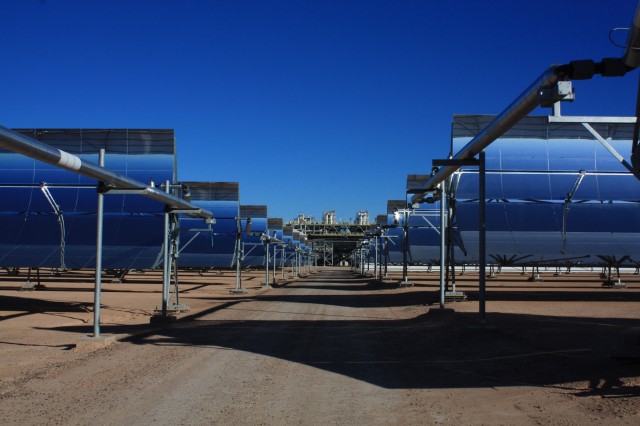In the US, the future of solar energy will be made in California. Earlier this month, the state’s governor signed legislation that commits California to obtaining half of its electricity from renewable sources by 2030. And to some extent, that future is now—the state’s utilities are working to meet a goal of one-third renewables by 2020.

In a lot of ways, this should be easy for California. The price of solar power has plunged—for utility scale solar, it can be cheaper to build and operate a plant (given existing incentives) than it is to simply supply fuel to a natural gas plant. Plus, countries like Spain and Germany (which also has a goal of 50 percent by 2030) have already done extensive solar rollouts and can provide valuable lessons.
And on top of that, California is nearly ideal solar territory. Extensive deserts and scrubland see mostly cloudless days and little of the dust that plagues deserts in other parts of the world. These regions are generally close to major urban areas and existing transmission infrastructure, and you’d expect that California would have a relatively smooth time ramping up its renewable power.
But there are challenges inherent in the structures we use to handle and pay for electricity. Going half renewable doesn’t just strain the grid as a distribution method; it challenges the economic assumptions on which we’ve built our electric grid. To have a grid where half the power is supplied by intermittent renewable sources, we’ll have to completely rethink how we manage the electric grid.
So in many ways, solar power is likely to be a truly disruptive technology. And it’s likely to cause some destruction in the process of disruption.
What do we need from solar?
Remarkably little, as it turns out. Most classes of photovoltaic power—thin film, silicon, etc.—are seeing incremental improvements, and that’s likely to continue. But we’re unlikely to see any radical leaps in these areas. There are also a number of areas in active research, primarily involving concentrating solar power—technologies that focus sunlight on highly efficient (but highly expensive) photovoltaic devices. So far, none of these technologies have gotten to the point where they’re close to competitive with traditional tech like silicon.
We talked to two people who focus on solar energy at the Department of Energy: Landis Kannberg of the Pacific Northwest National Lab and Paul Basore, a Principal Engineer at the National Renewable Energy Laboratory. Neither of them knew of any technologies in the works that were likely to reduce the costs of installation or support hardware.
Silicon photovoltaics have gotten so cheap, in fact, that the panels themselves are only a small part of the total expense of installing a system. This is the one thing that could make concentrating solar economically viable. As installation and permitting costs grow to dominate the price of photovoltaics, it starts to become more economical to harvest more energy from each panel—precisely what concentrating solar allows. However, it’s not certain that this trend will ever intersect the price trend of concentrating solar.
Plus there’s a non-technological solution to the cost of installation: simplifying the permitting process. “You only have to look to Europe to see that it could be a lot better than it is now in the US,” Basore told Ars. “In Italy, modules there are less than half the cost. It’s gotten to the point where modules are maybe a third of the cost in Europe. In the US, we approach that at utility scale. But anything smaller than utility scale in the US, the modules become an almost negligible part of the total cost.”
Other areas where policy could help out is a consistent approach to tax credits. “In the US at least, the changing policies relative to tax credits has a whipsaw effect on demand,” Kannberg told Ars. That, in turn, has sent mixed messages to hardware manufacturers. But the market has now grown to the point where the specific policy in place in the US doesn’t have as much of an effect on global manufacturing. “The prices are dropping or have dropped to where, at least from an international standpoint, it’s a pretty compelling technology now, and I suspect that manufacturing capacity may soon become an issue.”
Assuming manufacturing continues to ramp up, supplying California with the hardware it needs shouldn’t be a problem. And if the US can get its policy house in order, getting that hardware to homes should be manageable as well.
What does a 50 percent renewable grid look like?
We don’t have to imagine what California’s 50 percent renewable grid will look like. Since their businesses depend on it, a number of California utilities asked a group of analysts to look into it. The organization they hired modeled a variety of different potential scenarios, including some with a diverse portfolio of renewable sources and some relying heavily on rooftop or utility-scale solar.
The biggest challenge with going to half renewables is overgeneration. The state receives power from a number of sources that simply can’t be shut down—combined heat and power systems and nuclear plants, for example. Layered on top of that are renewable sources like solar that generate power whether you want them to or not. This isn’t a problem with California’s 2020 goals (33 percent renewables) even on sunny days in the spring. But by the time the grid reaches 40 percent renewables, there could be as much as five GigaWatts of overproduction on a sunny afternoon. At half renewables, there’s a staggering 20GW of overproduction.
By 5pm, however, the overproduction is gone. As people get home from work and start the largest demand peak of the day, stored electricity and out-of-state imports have to be called into play to meet it.
The analysis found a variety of ways to limit the impact of this overproduction. The simplest is storage. California has targeted adding 1.3GW of storage to its grid within the decade, and it currently has about three Gigawatts of pumped hydro, the most economic form of storage. But given the recent drought, it’s not clear whether all of that will be available at any moment. In any case, it’s not going to be sufficient to absorb all of the overproduction, even assuming the storage was empty to start the day.
Other options include diversifying the mix of renewables used to reach the 50 percent goal. A scenario that supplemented the photovoltaics with other sources—such as biomass, wind, geothermal, and solar thermal power—cut the overproduction by roughly half. Further efforts to integrate California’s grid to those of surrounding states would also allow it to export some of the excess. All of these things would help to varying degrees, although it’s still likely that some electricity would have to be discarded.
All of it comes at a cost. The 33 percent renewable grid isn’t expected to add significantly to the rates California consumers would pay; they’d go up, but largely from work that would have to be done anyway. By going to 50 percent, however, the report estimates the state’s rate payers will be on the hook for an increase of anywhere between nine and 23 percent.
[“source-arstechnica”]





